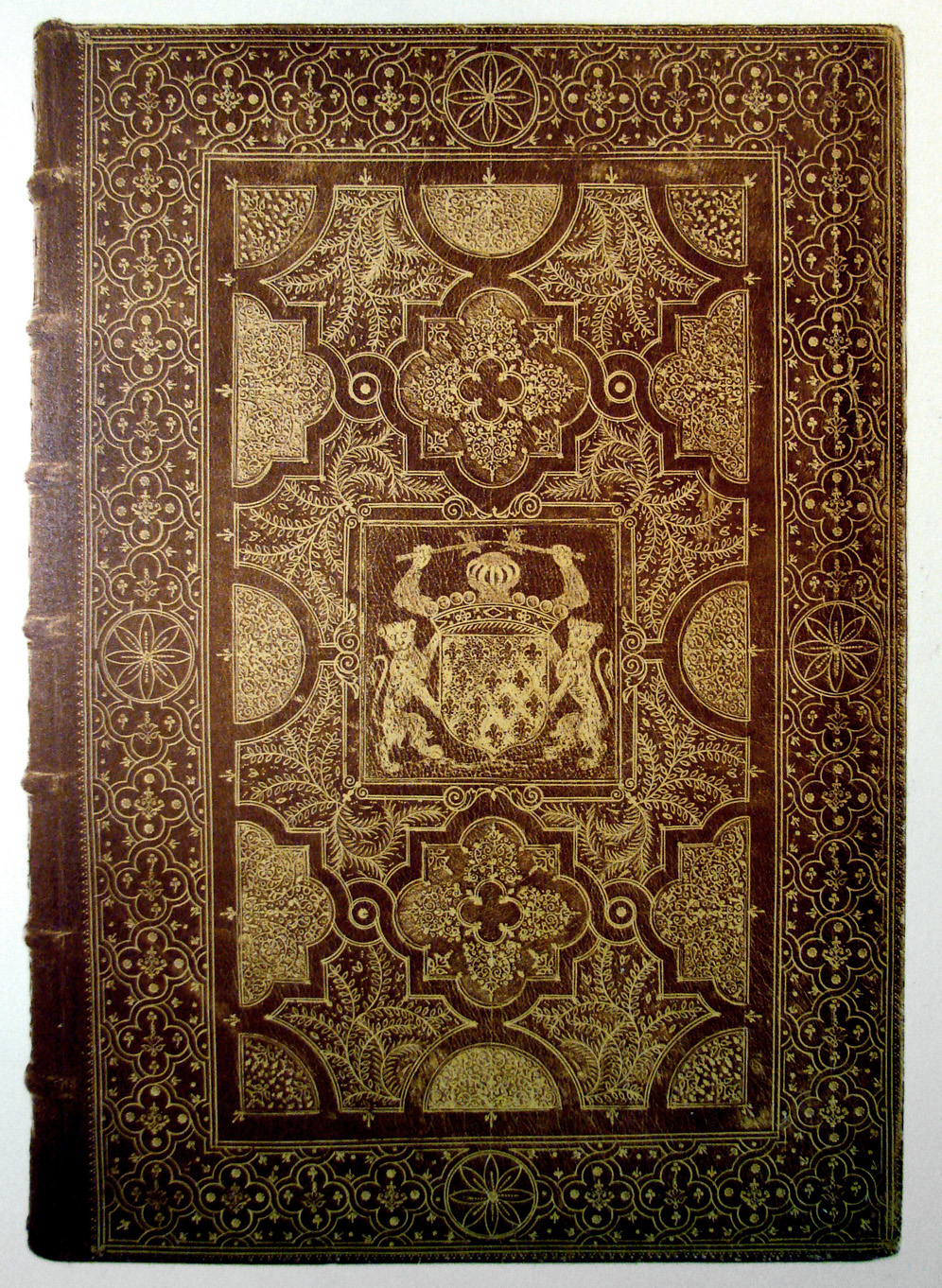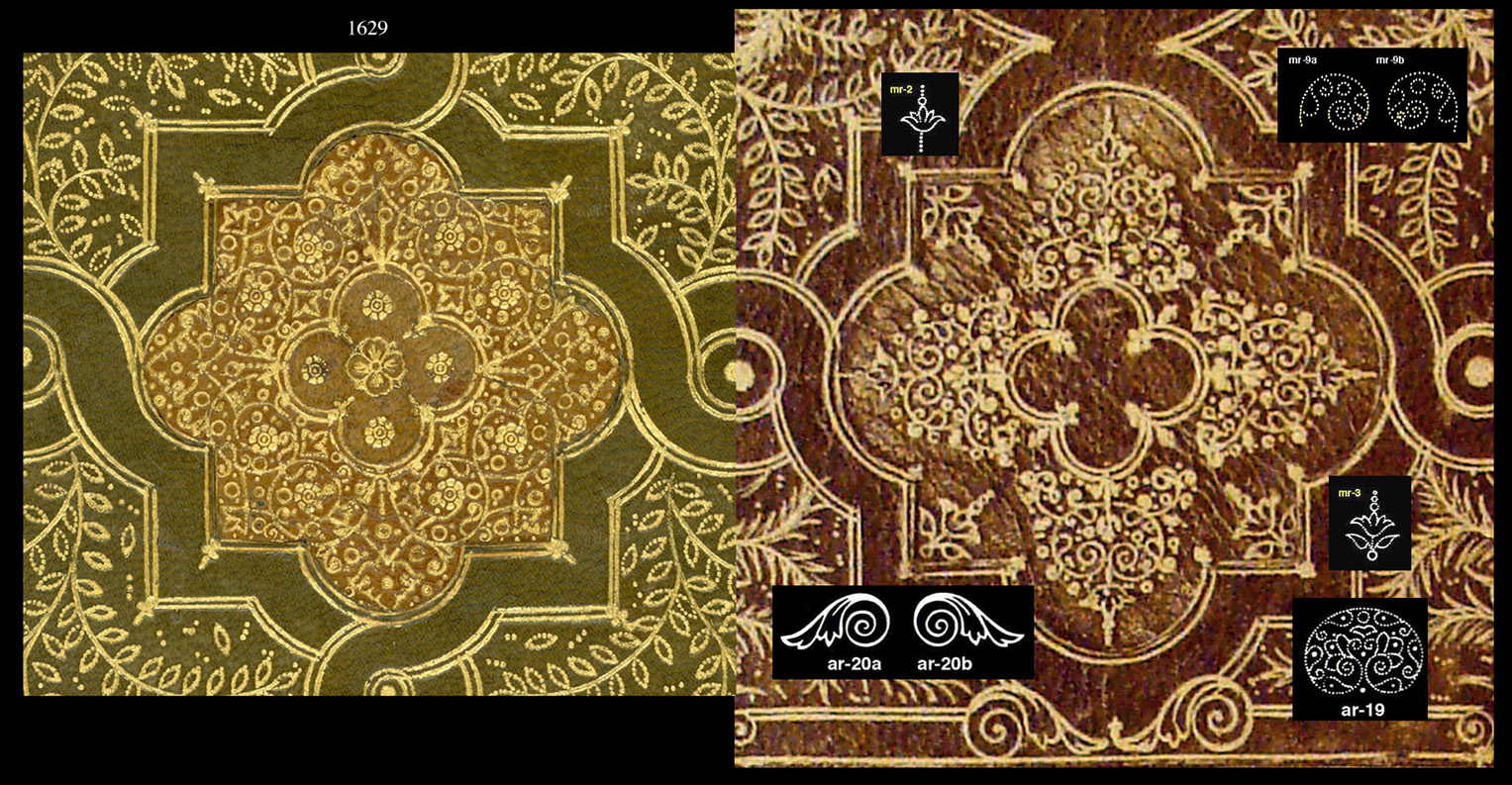

|
The reproduction shown above is from a 1910 Vienna publication Holbibliothek Bucheinbände by an Austrian Librarian, Theodore Gottlieb (1860-1929). This rare collection of 100 Imperial folio sized plates, is very expensive, and I was lucky to find someone who was good enough to send me a photo of Plate 53 The original reproduction is tinted red and was somewhat distorted in the photo, I have reproduced it here with much of the distortion corrected. Esmerian lists this binding in his Tableau II - ATELIER DE MACÉ RUETTE envoron 1606-1638, under the heading "FANFARES" MODERNES. as the first example of a fanfare binding by Macé Ruette and tentatively dates the production of it as 1621 due mainly, I suspect, due to the fact that this binding covers a 1621 printing ( La Sainte Bible Pierre Frizon, (2 vol.) Paris Richer Chevalier, 1621) While I was studying this and another large fanfare binding (see a large 1629 example) I noticed one major difference, the lack of the imprints mr-2 and mr-3, these imprints are entirely lacking in the 1629 binding and yet are so prevalent here and in most other bindings that followed. This may be an important change and suggests that this binding was made after the 1629 binding. Esmerian also notes a similar timing in the use of different tools, from 1620 to 1630 the fleuron used for the interior frame was a small vase of flowers, after 1630 it was replaced by a larger imprint (fer a gerbes). Changes also in the roulettes used inside the covers were observed, one was replace in 1629 that then lasted till 1634. More mysterious is the appearence of a scroll wing (volute) that is found placed in pairs in cardinal positions around the central arms (see below ar-20a+b). This 5 lobed volute was not used again until 1661 some 30 years later, did it get lost in a drawer? Or was it stolen? The binding on which appears in 1661 may in fact be a forgery (see this page for more details). |

|
In Comparative Diagram 1, we can clearly see major differences in the tools and techniques used, the 1629 binding retains the old Macé way of making spiral decoration with small tools, painstaking detailed work, in the 1630 binding we see the use of ready made spirals and different tools such as mr-2 mr-3. Now in 2013, I have found in an Alde auction catalogue information claiming that Macé Ruette became the Kings binder 1629 and not 1634 as claimed by all experts previously "Macé Ruette (1584 - v. 1644) qui portait le titre de Relieur du Roi dŹs 1629 (et non 1634 comme l'ont dit Thoinan et Esmerian)". Here then could be part of the reason behind these changes that occur around 1629! Could it be that Mace Ruette decided that his pointille decoration made with small tools was not as classy and precise as it could be with ready made spirales and new pointille tools, more fitting for Royal bindings? or.... was he suddenly swamped with a lot of new work and needed labor saving tools? I would further like to point out something very interesting in terms of tool progression and transformation, or evolution. We see in the 1630 binding the use of ready made spirals mr-8a, mr-9b, these have been placed back to back and then further embellished with small tools. Sometime near the mid century Antoine Ruette invented, or was anyway using the double spiral tool, which effectively gives the same result as placing the spiral pairs back to back, in a single tool (see ar-19). This double spiral tool was copied by the Caumartin shop and the Charenton workshop. This was a great time saving device compared to the way Macé was doing it in the old days. (see further details here) As a final note in consideraing all of the above we must consider the date of 1630 for the binding shown at the top of the page as only provisional, almost certainly it was not made before 1629, and possibly it could be from a later date such as 1633 or later. |
| information about the author | return to the home page of VIRTUAL BOOKBINDING |